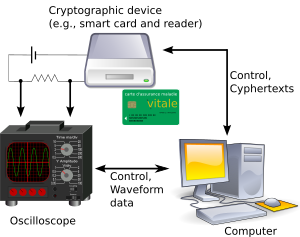- In cryptography, power analysis is
a form of side channel attack in which the attacker studies the power consumption of a cryptographic hardware device (such as a smart card, tamper-resistant "black box", or integrated circuit). The attack can non-invasively extract cryptographic keys and other secret information from the device.
Simple power analysis (SPA) involves visually interpreting power traces, or graphs of electrical activity
Differential power analysis (DPA) is a more advanced form of power analysis, which can allow an attacker to compute the intermediate values within cryptographic computations through statistical analysis of data collected from multiple cryptographic operations
https://en.wikipedia.org/wiki/Power_analysis
- Using this information, the DPA attack uses the following steps:
Use the current/previous plaintexts and ciphertexts to calculate four different
For each of these calculated inputs, use one bit of the input to split the traces into two groups
Calculate an average trace for each group and subtract them to get four differential traces
Look at the differences to decide which mode is most likely:
If one of the differential traces shows a large spike, the target is probably using that mode
If none of the differential traces has a large spike, the target is probably using CTR mode
https://wiki.newae.com/Investigating_Block_Cipher_Modes_with_DPA


No comments:
Post a Comment